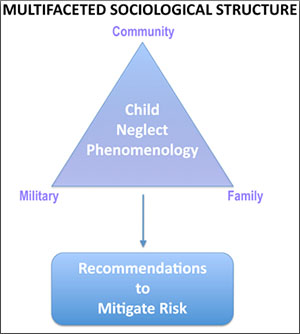Posted May 14, 2015
Stephen J. Cozza, M.D., Uniformed Services University of the Health Sciences
 It has been estimated that 2.5 million American-service members have been deployed in wars since the September 11, 2001 attacks on our nation. Of those deployed to Afghanistan and Iraq, about 37,000 Americans have been deployed five times, and 400,000 more than three times. The increased rates of combat deployment, tracked by the congressionally mandated program Personnel Tempo, have been associated with increasing rates of child maltreatment and child neglect in the U.S. Army. This finding suggests a tie among combat deployment, military family stress and child maltreatment. A clear understanding of the types, characteristics, onset conditions, and particular stressors of families in which child neglect occurs is needed to create military and community resources that may have a mitigating effect.
It has been estimated that 2.5 million American-service members have been deployed in wars since the September 11, 2001 attacks on our nation. Of those deployed to Afghanistan and Iraq, about 37,000 Americans have been deployed five times, and 400,000 more than three times. The increased rates of combat deployment, tracked by the congressionally mandated program Personnel Tempo, have been associated with increasing rates of child maltreatment and child neglect in the U.S. Army. This finding suggests a tie among combat deployment, military family stress and child maltreatment. A clear understanding of the types, characteristics, onset conditions, and particular stressors of families in which child neglect occurs is needed to create military and community resources that may have a mitigating effect.
Funded by two Intramural PTSD Investigator-Initiated Research Awards from the Psychological Health-Traumatic Brain Injury Program, Dr. Stephen Cozza at Uniformed Services University of the Health Sciences has sought to illuminate factors in the multifaceted sociological structure-consisting of family, community, and military-as contributing to or protecting against child neglect and related health issues. Dr. Cozza's approach was to survey and analyze clinical case records, analyze data from key informant questionnaires to measure community resource adequacy, and collect and analyze community multivariate data. Most prominently, he found that child neglect typically occurred with children under the age of 12, in young families of junior enlisted rank, where resources and parenting experience are more limited. Greater severity was generally identified in families where children were exposed to intimate partner violence. Combat-deployment periods likely posed unique risks to military families that contribute to child neglect, including both impairment in parental efficacy and higher levels of family conflict and/or violence. Dr. Cozza also illuminated a need to focus on types, sub-types and severity of substantiated child neglect in U.S. Army communities.
Based in the findings, Dr. Cozza has developed targeted-prevention recommendations to manage risk on-post and off-post. These recommendations include community resources such as physical health care, mental health care, retail and food services, recreational services, child care services, religious activities, family activities, and housing. Clinical efforts should be trauma-informed in that families should be taught parenting tools specific to injury-related challenges, provided problem-solving and conflict-resolution strategies, and provided specific information so they better understand the impact that chronic illnesses (e.g., PTSD, substance use, depression, and TBI) can have on children and families. Some of the resources should be in proximity to where military-service members and their families live. Often times stigma associated with mental disorders deter military members from seeking help, highlighting the need for local outreach and engagement strategies. Lastly, Dr. Cozza advocates that support programs should be sustained for these families who might need help for many years. Together, these will ensure the cohesiveness and emotional support, which in turn will influence both individual psychological and behavioral functioning and collective efficacy.

Publications:
Cozza SJ. Meeting the intervention needs of military children and families. J Am Acad Child Adolesc Psychiatry. 2015 Apr;54(4):247-8.
Cozza SJ, Cohen JA, Dougherty JG. Disaster and trauma. Child Adolesc Psychiatr Clin N Am. 2014 Apr;23(2):xiii-xvi.
Cozza SJ, Ortiz CD, Fullerton CS, McCarroll JE, Holmes AK, Harris AM, Buckley CL, Ursano RJ: Types, Subtypes and Severity of Substantiated Child Neglect in U.S. Army Communities from 2001 to 2009. In press.














